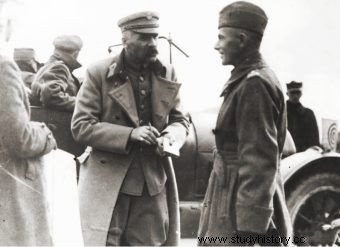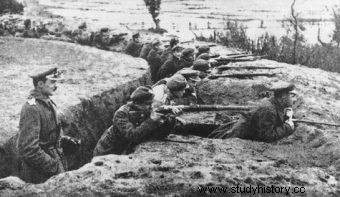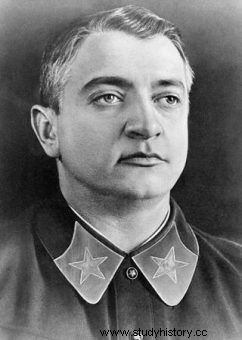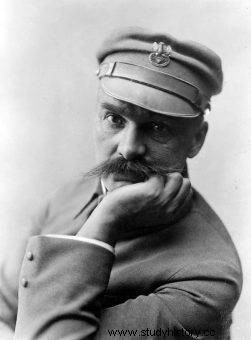Terrified Red Army soldiers abandoned their rifles, cannons, wagons and horses. They fled into the woods, fields, hid in ditches. Thousands of voluntarily gave themselves into captivity, waiting at the crossroads, for the cavalry of "Lord's Poland". The defeat was total. The mighty Red Army was completely disrupted. The enemy fled in panic or asked for mercy. What are we talking about? About the battle with the Bolsheviks on the Nemunas, which took place at the end of September 1920. Today it does not play such a role in the Polish consciousness as the Battle of Warsaw. Meanwhile, it was on the Nemunas that Piłsudski's troops dealt the final, decisive and knockout blow to the Red Hydra, sealing the victory in the Polish-Bolshevik war.
The so-called "Miracle on the Vistula" of August 1920 allowed the Polish side to take the initiative. After the defeat of Warsaw, the invaders from the east were forced to withdraw. Mikhail Tukhachevsky's troops retreated beyond the line of the Neman River. However, the future marshal of the USSR was convinced - as he wrote to Lenin - that this was not the end of the war with "your Poland". He thought that the Poles - yes - had broken the Red Army near Warsaw, but they put all their available forces into it . They cannot afford a second such effort.
On the Polish side, Piłsudski was aware that there was only a knockdown near Warsaw. enemy. Staying with the boxing nomenclature, it was necessary to make a second, decisive blow and knock out the opponent, send him to the boards.
The Chief of State was already working at the end of August on regrouping Polish troops and preparing for the main battle. He intended to use a maneuver similar to the one near Warsaw, i.e. to use the Assault Group, bypass Tukhachevsky's troops and hit them from the rear, in the Lida area. Then the Soviets were to be pushed towards the marshes of Polesie.

The main burden of this maneuver was to be taken by the 2nd Army of general Rydz - Śmigły
From there, a maneuvering group was designated to break through Lithuania to the rear of the enemy. The plan was to put the Russians in a death grip. While the maneuvering group would attack Lida, the main Polish forces were to advance from the west in the central part of the front, on Grodno and Wołkowysk, and push the Soviets beyond the Neman.
Piłsudski realized that the key to the success of such a trick would be to execute it as soon as possible and, of course, in full conspiracy . Therefore, the troops were to move only at night and without rolling stock. The commanders found out about the start of the offensive at the last minute, so that the Soviet intelligence would not know its date. The matter was also political. The West was reluctant to see the Polish offensive, even counteracted it . He preferred a strong Soviet Russia (promised to pay tsarist debts) than a strengthened Poland. It seemed to policymakers in London and Paris that the October Revolution was just a fad that would end soon. Not the first and (unfortunately) the last time they looked at the eastern giant through rose-colored glasses. Secondly:the maneuver in Lithuania violated its formal neutrality, which it announced in the Polish-Soviet war. In fact, however, the Lithuanians supported the Soviets, moreover, they took the opportunity and occupied part of the Suwałki Region.
Piłsudski's army numbered 70,000 soldiers. So the Soviets outnumbered them. They had a force of about 114,000. people. Just before the main clash, the Russians were pulling reinforcements from the hinterland. Thanks to this, they have recreated almost all branches near Warsaw . However, they were worse equipped and armed. They also lacked an element that Poles were well supplied with - a strong morale.
To Grodno
The first chord of the battle that lasted about a week was the Polish attack towards Grodno. Tukhachevsky considered it to be the beginning of the offensive on Grodno and ordered that the reserve should be withdrawn. He was convinced that this would be the main direction of the Polish attack.
Fierce, several days long fights for the city began. Initially, the Poles were surprised by the strong resistance of the defenders of Grodno. The command believed that the Russians would be very much demoralized by the defeat in Warsaw. However, this did not happen. A large part of the Soviet army, as well as the fresh forces drawn from the depths of Russia, did not suffer defeat and were still willing to fight fiercely .

Piłsudski's army numbered 70,000 soldiers
Parallel to the battles for Grodno, on September 22, an Assault Group set off from the forests of the Suwałki Region to Lithuania, the aim of which was to attack the Red Army from the north. The Poles, after dispersing weak Lithuanian forces and capturing Druskininkai, attacked the Soviets, surprising them completely. Until now, the Russians believed that Polish forces would focus mainly on Grodno. When it turned out that Piłsudski's troops were trying to close the Russians, Tukhachevsky decided to neutralize the maneuvering group. To this end, at the cost of weakening the position on the Nemunas, he organized a grouping of three divisions to break up the Polish rally in Lithuania. This proved to be a difficult task, however. Deprived of aviation and lacking intelligence, the Russians did not know in which direction the group would hit or where .
The specter of defeat and closure in the Polish cauldron was becoming real. On September 25, in the face of the growing advantage of the enemy, Tukhachevsky ordered a retreat. It was then that the Strike Group, on Piłsudski's orders, launched an attack on Lida, far behind the enemy's rear. The Soviets defended the city fiercely. The battle turned into bloody street fights. Ultimately, however, the reserve of the 1st Legions Infantry Division introduced into the fight forced the Bolsheviks to flee with a strong fire . The fighting ended with the complete panic of the Russians. As many as 10,000 soldiers, 25 guns, two thousand combat vehicles, 52 machine guns, over a hundred horses were taken into captivity in Poland.
Follow the Bolshevik!
The other arm of the Polish vice were the uhlans on the southern section of the front. General Franciszek Krajowski's Cavalry Group joined the fight. On September 27, 1920, the cavalrymen set off for Pinsk, cutting off the 4th Soviet Army from the remaining forces. 3,000 people were taken prisoner, including the army staff itself. Then the Poles moved towards Baranowicze. On the other hand, in the north, in the area of Lida, there was a Strike Group. The grip tightened more and more, finally crushing the Red Army. The retreat of the Russians turned into a panic escape. A large part of the soldiers - especially of Ukrainian and Belarusian origin - went to the Polish side .

When it turned out that Piłsudski's troops were trying to close the Russians, Tukhachevsky decided to neutralize the maneuvering group
From the beginning of October 1920, the war became de facto the great pursuit of the escaping, disorganized enemy forces. It is from this period that many cranes come from - popular chants of lancers, praising the victories of individual units. The famous phrase ran through their chorus: battle lances, sabers in hand, Bolshevik chase, chase, chase!
Red Army soldiers in roadside abandoned their weapons. There was a lot of equipment on their retreat trail. Poles took thousands of prisoners of war. An example is the city of Korosten in northern Ukraine. After it was captured by the 8th Cavalry Brigade of Colonel Rómml, as many as 8,000 were taken prisoner by the Polish army. captives. In the entire battle of Niemen, there were as many as 40,000 of them, or roughly 1/3 of the enemy's forces. Piłsudski's army also took over a lot of equipment:140 guns, thousands of weapons, as well as carts and horses .
Despite such a deplorable situation, or in spite of it, in early October desperate Tukhachevsky gave an absurd order to fight at all costs.
"Commanders, Commissars, Communists! Your socialist homeland demands new efforts from the front ranks. Conquest or Death! Death or Victory! Forward! ”
His words sounded grotesque given the scale of desertion and disorganization on the Russian side. On October 12, 1920, the Poles conquered Mołodeczno, and on October 15, Minsk. On October 18, Piłsudski sent his soldiers the last order in this war:
"Soldiers! You spent the first two long years of the existence of free Poland in hard work and bloody toil, you end the war with a great victory, and the enemy - broken by you, finally agreed to sign the first and main principles of the longed-for peace. Soldiers! Your efforts have not been in vain or in vain. Modern Poland owes its existence to the wonderful victories of the Western powers over the partitioned states, but from the very first moment of free Poland's life, many lustful hands were stretched out to her, a great deal of effort was made to keep her in a state of powerlessness, so that if it exists, it would be a plaything. in the hands of others, a passive field for the intrigues of the whole world. […]
Soldiers! You have made Poland strong, self-confident and free, you can be proud and satisfied with the fulfillment of your duty . A country that in two years was able to produce such a soldier as you are, can look to the future with confidence. Thank you again.
Read also:Why did Józef Piłsudski become the leader of Poland? It is largely thanks to this woman
An unused victory?
The Battle of Germany continued in parallel with the peace talks in Riga. The news that the Soviet troops had been smashed to dust improved the negotiating position of Poles. Piłsudski realized, however, that despite the enormous success, the further war was not supported by society . The people wanted peace.

The plan was to put the Russians in a death grip
Ultimately, the Polish side negotiated 114,000. km. more square areas in the east than it would be in the case of the border on the so-called the Curzon line (in August 1920, such demands were made by the Soviets). In the Polish state, roughly the size of the Polish-Lithuanian Commonwealth before the Third Partition, there were an additional 4 million people of Polish nationality. The border was drawn based on the Dzwina, Dzisna, Polesie marshes and the Zbrucz line in the south-east.
Nevertheless, there are still voices today that in the face of such a great victory and the terrible situation of the Soviets tied by a civil war with "white" generals, much more could be obtained. . The Soviet army was in disarray. It was even possible to play for the pre-partition, territorially great Republic of Poland.
An extreme and controversial thesis on this subject was formulated by the journalist and author of historical books, Piotr Zychowicz. According to him, Piłsudski was able to overthrow the regime in Moscow and thus save the world from the hell of communism during the Kiev expedition - in 1919 and a year later . It would be enough if he continued the offensive, and then the Soviets would not be able to fight simultaneously with Poland and the "white" generals. According to Zychowicz, in 1919 Piłsudski was to reject the offer and requests of General Denikin for cooperation and support of the tsarist generals. According to this author, the Commander-in-Chief did not decide to cooperate with the "whites" because, as a former prisoner of tsarism, he had a sincere hatred for tsarist Russia. In 1920, after the defeat of the Bolsheviks on the Nemunas and a swift pursuit to the east (Poles covered up to 60 km a day. Apart from Minsk, they almost stood on the outskirts of Kiev), for the second time there appeared not only a chance to rebuild the pre-partition Poland, but also to crush the Bolsheviks, thanks to the cooperation of with Wrangl - another "white" general. And Piłsudski did not take advantage of this opportunity.

Piłsudski already during the Kiev expedition - in 1919 and a year later - was able to overthrow the regime in Moscow and thus save the world from the hell of communism
On October 12, the Poles and the Bolsheviks signed a ceasefire. Our army was like a speeding horse whose reins had suddenly been pulled back. To the amazement of the Bolsheviks - and the despair of Poles from the East - our army stood still, followed by peace negotiations, which ended with the signing of the Polish-Bolshevik peace in Riga in March 1921 . Under its provisions, we were given catastrophic borders in the east. And the Bolsheviks calmly finished Wrangel. There was the agony of white Russia and the final triumph of Bolshevism ... - Zychowicz explained in one of the interviews.
His thesis, which he described in the book "The Pilsudski-Lenin Pact", is still the subject of controversy and analysis by historians. There will be many more attempts to answer the question whether the potential of the Battle of the Nemunas was wasted, or if there was no other way out. Regardless of this, it is worth being aware of the great victory of the Polish army, which broke the power of the invading Red Army, trying to penetrate deep into Poland and Europe with the communist revolution.
Internet:
- Piotr Zychowicz:Due to Piłsudski's mistake, Poland did not become an empire - WP Opinions - accessed:09/21/2021
- Battle of the Nemunas 1920:the last great victory | Historia.pl - History of Poland - accessed on 09/21/2021
